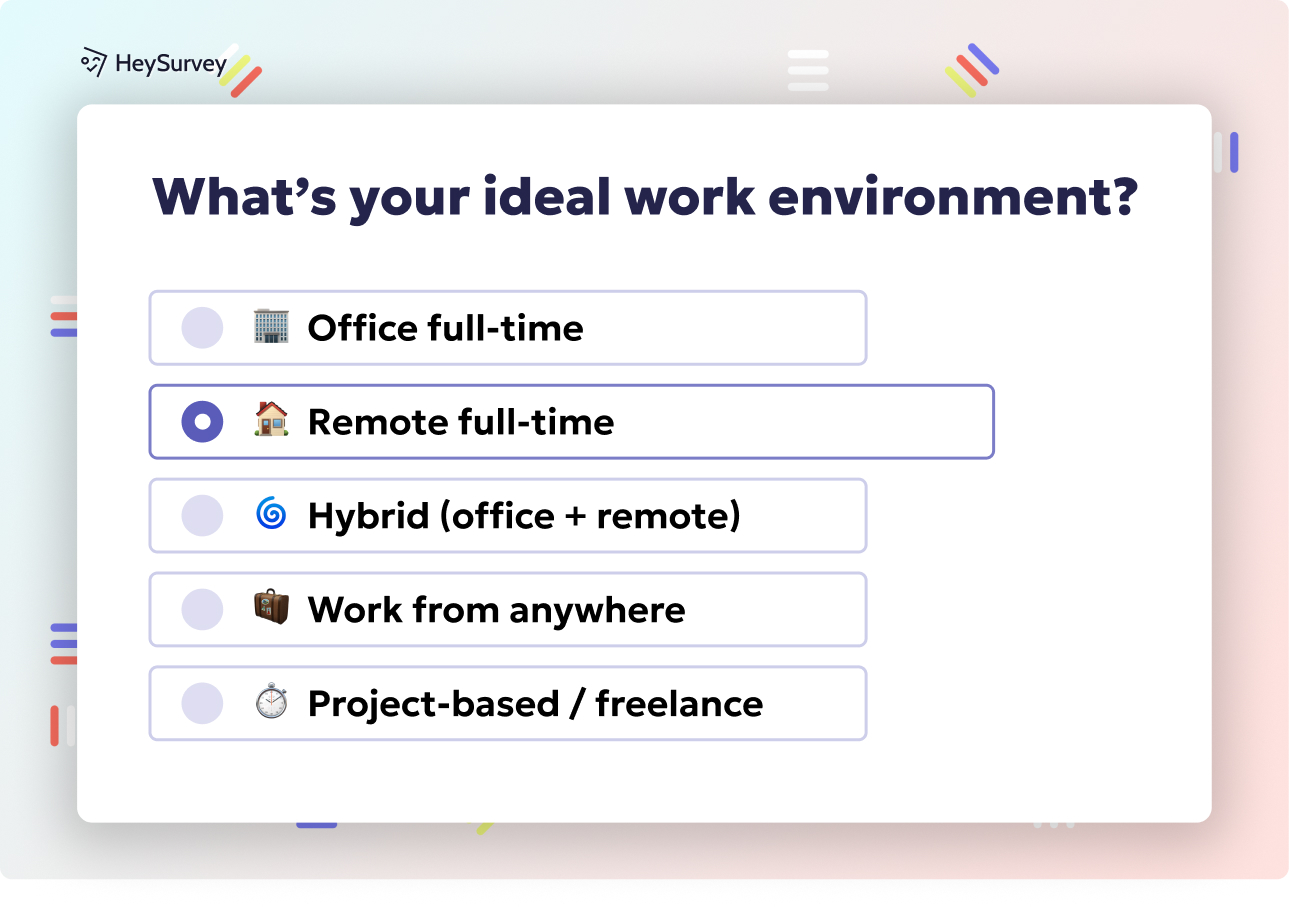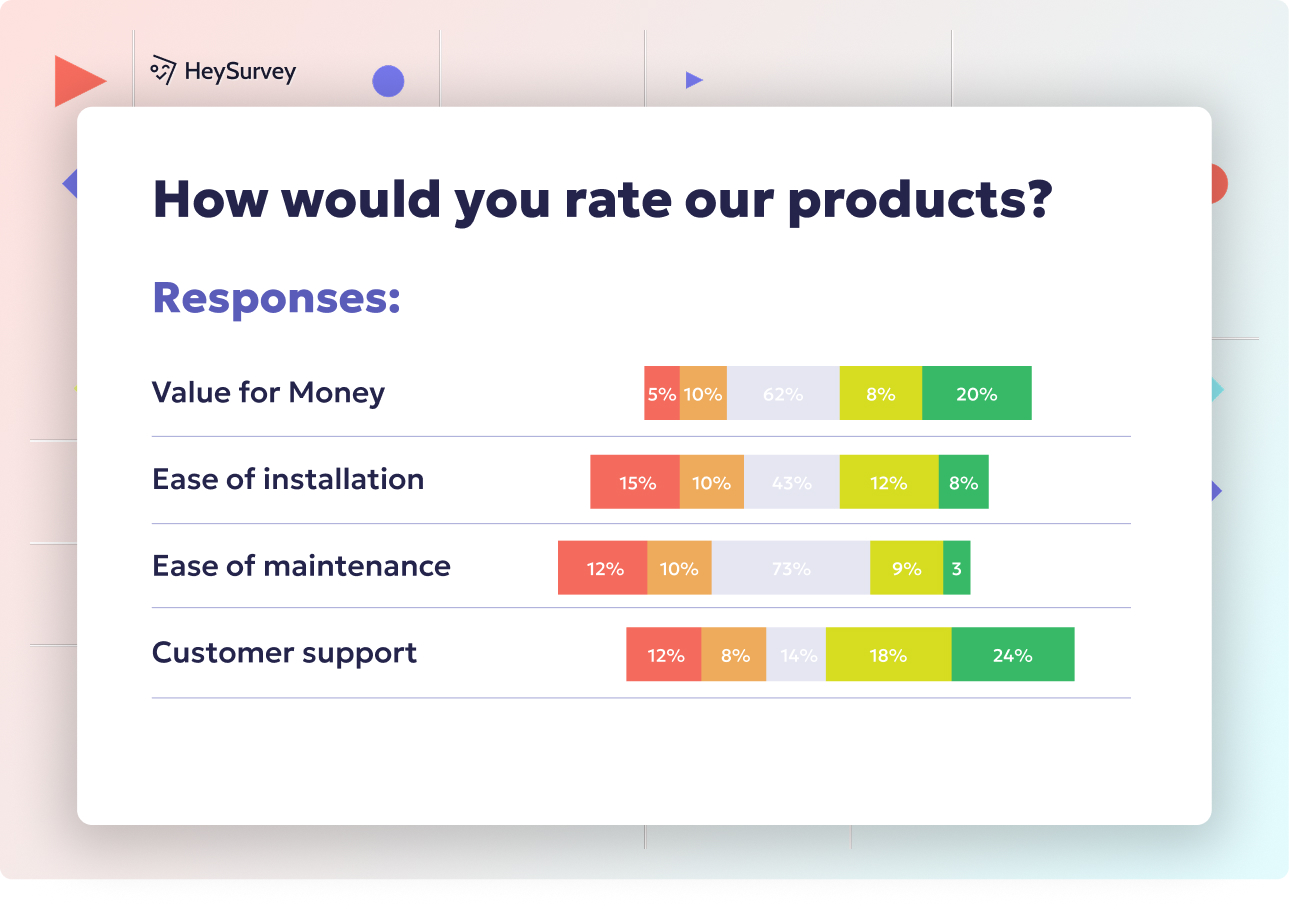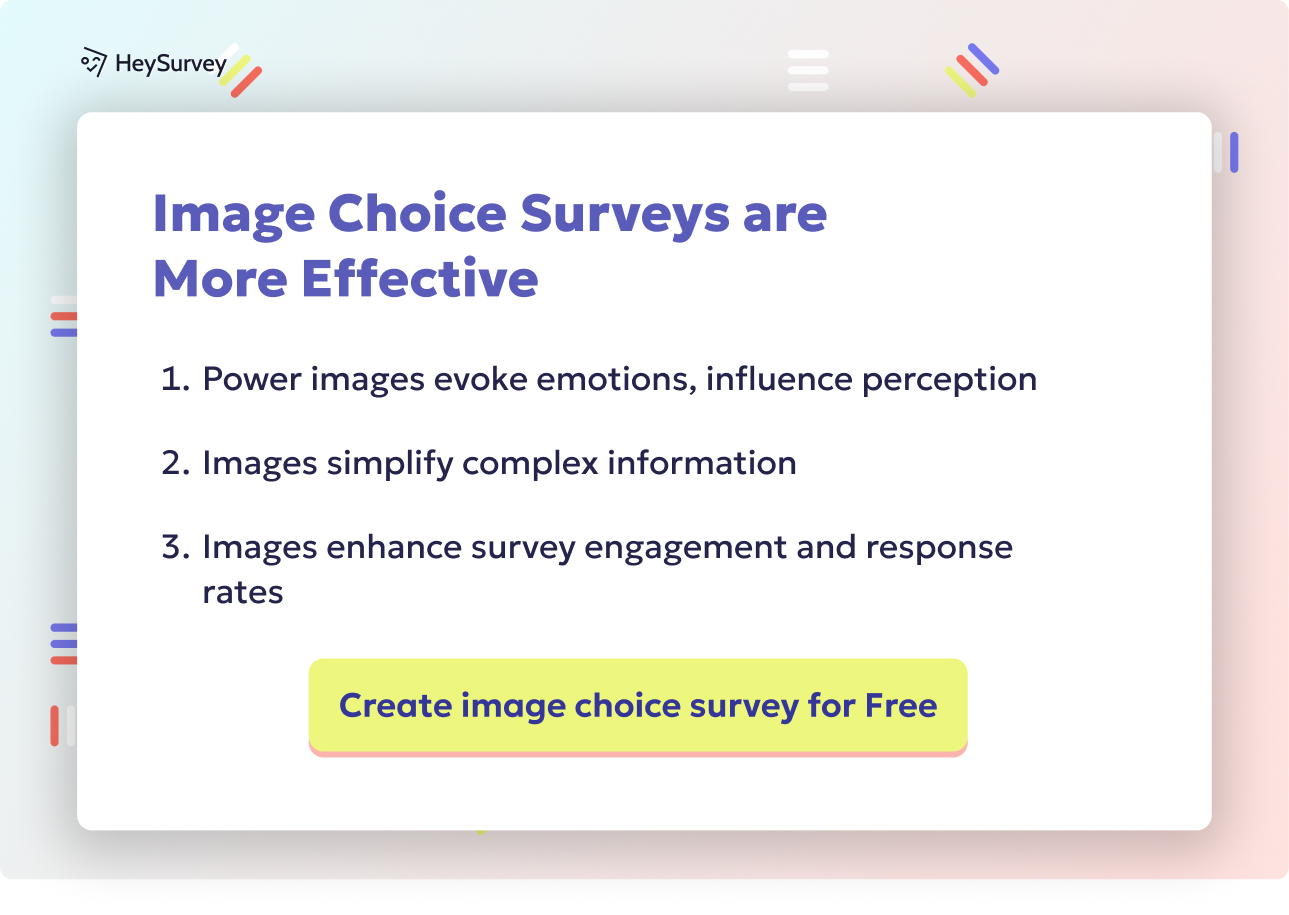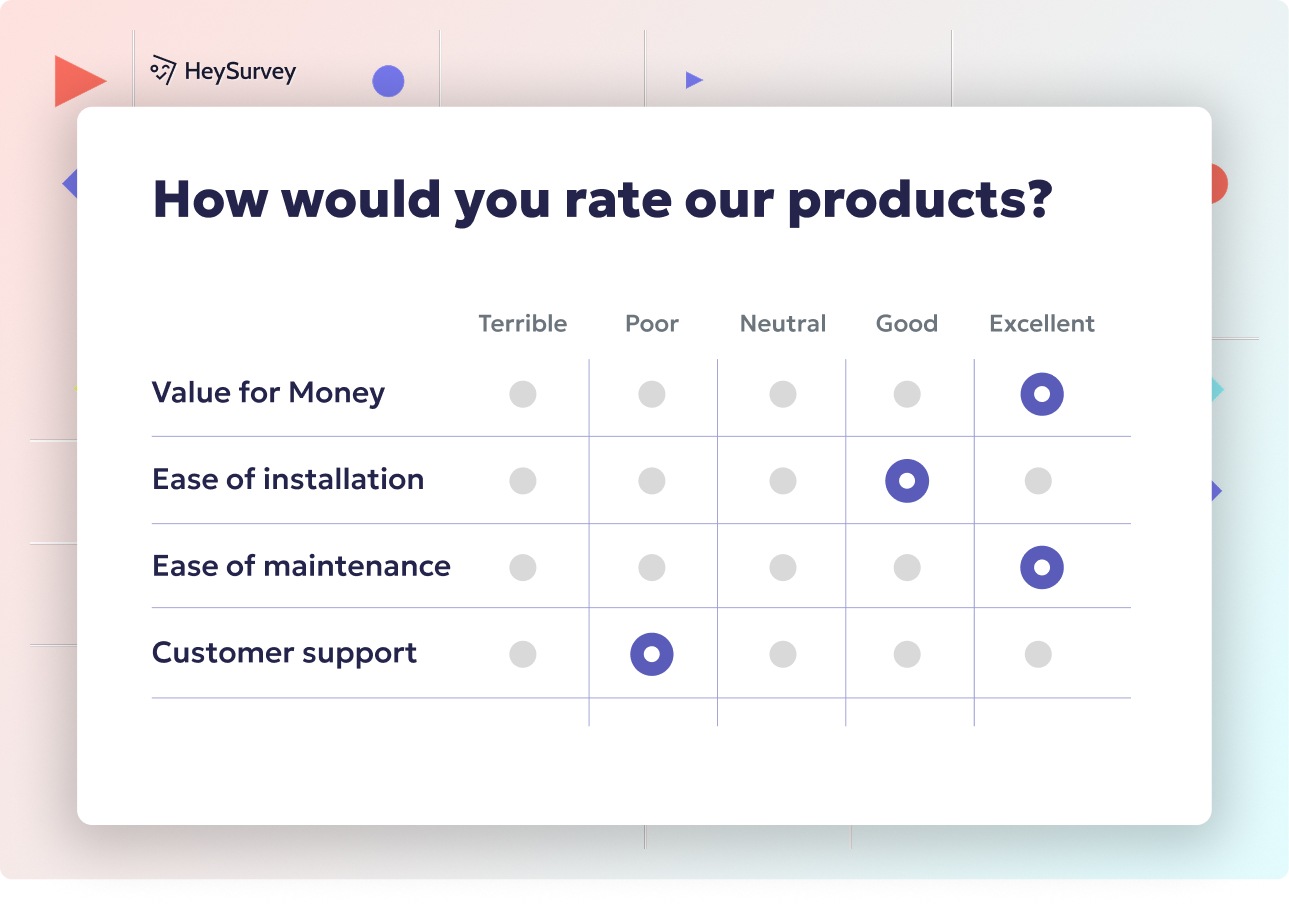27 Self Esteem Survey Questions: A Complete Question Guide
Discover 30+ effective self esteem survey questions across 7 formats to measure confidence, self-worth, and boost insights with ease.
Self-Esteem Survey Questions: The Complete Guide to Choosing the Right Question Types
Understanding self-esteem is like peering into a mirror that reflects our inner thoughts and feelings. It's a measure of how we value ourselves and plays a pivotal role in our daily lives. Whether you're in business, healthcare, human resources, or education, assessing self-esteem can provide valuable insights. But here's the catch: the way you design your survey can make or break the quality of your data. A well-crafted survey not only boosts response rates but also ensures the information you gather is both reliable and actionable. In this guide, we'll explore seven distinct question formats to help you measure self-worth effectively.
Likert-Scale Self-Esteem Surveys
Why & When to Use
If you're looking to benchmark overall trait self-esteem and track long-term trends, the Likert scale is your best friend. It's perfect for large samples, online panels, academic research, and employee engagement programs. This scale offers a range of responses, allowing you to capture the intensity of feelings.
5 Sample Questions
- "I feel that I have a number of good qualities."
- "On the whole, I am satisfied with myself."
- "I feel I do not have much to be proud of."
- "I am able to do things as well as most other people."
- "I take a positive attitude toward myself."
Note: The third question is reverse-scored to balance the scale.
The Rosenberg Self-Esteem Scale (RSES) is widely used to measure global self-esteem, but its factor structure varies across cultures, with some studies supporting a unidimensional model and others indicating a two-factor model. (econtent.hogrefe.com)

Creating a self-esteem survey with HeySurvey is a breeze—even if you’re new to the platform! Here are 3 easy steps to get you started, plus some bonus tips to make your survey truly yours.
Step 1: Create a New Survey
Head over to HeySurvey and start by clicking “Create Survey”. You can either:
- Choose a template designed for self-esteem or confidence surveys (best for a fast start), or
- Create a brand-new survey from scratch with the “Empty Sheet” option.
Once you pick your path, the Survey Editor opens—this is where the magic happens. You can change your survey’s internal name here to keep things organized.
Step 2: Add Questions
Click the “Add Question” button at the top or between existing questions to build your survey. HeySurvey offers various question types perfectly suited for self-esteem surveys, including:
- Scale questions like Likert or Semantic Differential,
- Choice questions for yes/no or multiple options, and
- Text questions if you want open-ended responses.
Simply type your question text, add descriptions if you want, and customize answer options. Remember to mark important questions as required to get complete data.
Step 3: Publish Your Survey
Once your questions are ready and you’re happy with the design, click “Preview” to see how it looks from a respondent’s view. Happy with the flow? Hit “Publish” to make your survey live and grab the shareable link.
Note: Publishing requires creating a free account so you can track responses later.
Bonus Steps: Make It Truly Yours
- Apply Your Branding: Add your logo and customize colors & fonts via the Designer Sidebar to fit your company or project style.
- Define Survey Settings: Set start/end dates, limit responses, or redirect respondents after completion using the Settings Panel.
- Add Branching: Use branching logic to tailor questions based on previous answers, ensuring respondents only see relevant items.
Ready to dive in? Just hit the button below to open a specially crafted self-esteem survey template and start customizing!
Learn more about HeySurvey’s powerful features and tips in our full guide.
Semantic Differential Self-Esteem Surveys
Why & When to Use
This format captures the nuanced emotional tone of self-esteem. It's ideal for marketing research, brand perception studies, and therapeutic check-ins. Plus, its visually engaging format is a hit on mobile devices, leading to higher completion rates.
5 Sample Questions
Rate yourself between the paired adjectives:
- Worthless 1 2 3 4 5 Valuable
- Insecure 1 2 3 4 5 Secure
- Powerless 1 2 3 4 5 Powerful
- Doubtful 1 2 3 4 5 Confident
- Inferior 1 2 3 4 5 Superior
Research indicates that semantic differential self-esteem surveys effectively capture nuanced emotional tones, making them valuable in marketing, brand perception, and therapeutic contexts. (simplypsychology.org)
Short-Form (Rosenberg) Adapted Self-Assessment Surveys
Why & When to Use
Pressed for time? These condensed 4- to 6-item versions are perfect for quick assessments, in-app pop-ups, or pre/post-intervention testing. They maintain validity while minimizing survey fatigue.
5 Sample Questions
- "I feel that I’m a person of worth, at least on an equal basis with others."
- "I feel I have a lot to offer."
- "I wish I could have more respect for myself."
- "All in all, I am inclined to feel that I am a failure."
- "I feel confident about my abilities."
Note: The fourth question is reverse-scored.
Peer-Reported Self-Esteem Surveys
Why & When to Use
Sometimes, we don't see ourselves as others do. Peer-reported surveys capture observable confidence cues, making them invaluable in 360-degree feedback, classroom peer reviews, and social-skills research. They help uncover blind spots and social perception gaps.
5 Sample Questions
Asked about the target person:
- "Seems comfortable expressing opinions in a group."
- "Handles criticism without becoming defensive."
- "Appears proud of accomplishments."
- "Often puts self down."
- "Takes initiative in new situations."
Peer assessment enhances student learning by providing personalized feedback that scales to large classes. (arxiv.org)
Event-Specific (State) Self-Esteem Surveys
Why & When to Use
Ever felt on top of the world after a big presentation? Event-specific surveys measure situational boosts or dips in self-esteem, making them perfect for post-event assessments, therapy sessions, or marketing events. They provide real-time insights for coaching and program adjustments.
5 Sample Questions
- "Right now, I feel proud of myself."
- "At this moment, I doubt my abilities."
- "Immediately after the event, I felt respected by others."
- "Currently, I feel capable of handling challenges."
- "This experience made me question my self-worth."
Daily Diary / Micro Self-Esteem Surveys
Why & When to Use
Want to track self-esteem fluctuations over time? Daily diary surveys are excellent for well-being apps, CBT homework, and longitudinal studies. They provide rich time-series data for predictive analytics.
5 Sample Questions
- "Today I felt confident tackling my tasks."
- "I criticized myself more than usual today."
- "I felt admired by others today."
- "I believed in my ability to succeed today."
- "I felt inferior to those around me today."
Self-Esteem Survey Best Practices: Dos and Don’ts
Dos
- Use validated scales: Ensure your questions are backed by research.
- Balance positive/negative wording: Avoid leading respondents.
- Ensure anonymity: Encourage honest answers.
- Pilot test: Catch issues before the real deal.
- Time-stamp for longitudinal work: Track changes over time.
- Optimize for mobile: Make it user-friendly.
Don’ts
- Avoid double-barrelled phrasing: Keep questions clear.
- Cultural bias: Be inclusive.
- Excessive reversals: Don't confuse respondents.
- Leading language: Stay neutral.
- Overly long surveys: Respect their time.
Scoring and Interpretation
Once you've gathered your data, scoring is crucial. For instance, the Rosenberg Self-Esteem Scale assigns values to responses, with higher scores indicating higher self-esteem. Interpreting these scores requires context, so always link findings to appropriate interventions for those with low scores.
In conclusion, measuring self-esteem is more than just asking questions; it's about asking the right questions in the right way. By choosing the appropriate survey format and adhering to best practices, you can gain meaningful insights that drive positive change.
Related Question Design Surveys

29 Quantitative Survey Research Questions Example for Success
Explore 25+ quantitative survey research questions example with clear explanations and tips for c...

32 Good Survey Question to Boost Your Data Quality
Discover how to craft good survey questions with 30 sample questions across 8 types for better da...

31 Survey Question Mistakes You Need to Avoid Today
Discover 25 common survey questions mistakes with real examples and expert tips to craft clear, u...

